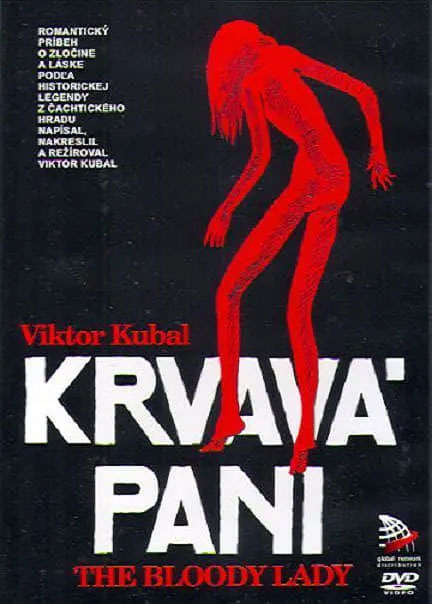Film Name: 血色女人 / The Bloody Lady / Krvavá paní

This animated film, based on a Czech folk tale, was created by Czech animator Viktor Kubal in 1980. Thus, it remains quite distant from us in terms of temporal, spatial, and cultural separation.
I find the film’s minimalist artistic style quite distinctive. Both the heroine in the castle and the hero who rescues her rarely reveal their expressions, their hair consistently obscuring most of their faces, which adds a significant air of mystery to the film. Each character’s color palette, from clothing to hair, generally doesn’t exceed three hues. The protagonists are predominantly light tones centered around white, while the servant infested by parasites is rendered in dark tones. This contrast between brightness and gloom aligns with the characters’ roles.
The animation flows smoothly overall, with clear transitions in lines and color blocks. However, some character movements feel oddly inconsistent. For instance, during the fight between the male protagonist and the heroine’s servant in the tavern, the servant’s actions—like jumping on the table and falling to the ground—appear somewhat unrealistic. This isn’t to say animation must be hyper-realistic, but rather that an animated film should maintain stylistic consistency in its movement patterns. The actions of these characters feel disjointed from the rest of the animation.
The most profound question this animation leaves me with is: What purpose did the female protagonist serve in giving her heart to the male protagonist, only to transform from a kind person into a cruel one? Typically, when protagonists meet, it’s common for the female lead to leave the male lead a token of their bond. They then part ways, ultimately reuniting driven by this token. Yet in this tale, the heroine—whose life was saved by the hero—gives him her very heart. This act transforms her into a cold, ruthless being. In essence, she sacrifices her capacity for love in the name of love itself.
A particularly striking sequence contrasts the heroine’s behavior before and after surrendering her heart—her attitude toward servants, her treatment of forest creatures, the shifts in her facial expressions. Essentially, the film uses surrealism to craft a bold moral dilemma around love: the heroine loves a man (no mistake), sacrifices her heart for love (no mistake), and becomes a “heartless” being (is that a mistake?).
This creates another emotional dilemma: Should the male protagonist accept her heart? Accepting it—as he does in the film—pushes her into moral ruin, for it was his love that objectively transformed her into a cold-blooded, ruthless woman. Refusing it, however, would negate the proof of their mutual affection.
As mentioned at the outset, since this film feels distant from our lives, many details remain puzzling—such as the significance of the castle gatekeeper wearing a fake beard, or why the acrobat swallows the gambling dice. Given the scarcity of online and written analyses of this film, this piece offers only a highly personal commentary. I myself found many aspects perplexing.
Finally, it’s worth noting that the film’s music is masterfully arranged, effectively setting the mood. Particularly striking are the organ compositions accompanying the thrilling sequences—truly magnificent.
Please specify:Anime Phone Cases » The Bloody Lady 1980 Animation Film Review: The consequence of losing love because of love